Abstract
AIM: To compare the interobserver variation in the pathological classification of ductal carcinoma in situ of the breast using two recently proposed classification schemes. METHODS: 11 pathologists classified a set of 25 cases of ductal carcinoma in situ chosen to reflect a range of lesions, using the traditional architectural classification together with the modified cytonuclear grading scheme of Holland et al and the Van Nuys classification scheme. Participating pathologists received a standard tutorial, written information, and illustrative photomicrographs before their assessment of the cases. RESULTS: Interobserver agreement was poorest when using the architectural scheme (kappa = 0.44), largely owing to variations in classifying lesions with a mixed component of patterns (kappa = 0.13). Agreement was better using the modified cytonuclear grading scheme (kappa = 0.57), with most consistency achieved using the Van Nuys scheme (kappa = 0.66). Most discordant results using the later scheme were due to inconsistency in assessing the presence or absence of luminal necrosis. CONCLUSIONS: Both the new classification schemes assessed in this study were an improvement over the traditional architectural classification system for ductal carcinoma in situ, and resulted in more reproducible pathological assignment of cases. The Van Nuys classification scheme is easy to apply, even to small areas of carcinoma, resulting in acceptable interobserver agreement between reporting pathologists. Additional work will be required to arrive at a consensus definition of necrosis for cases in the non-high-grade group.
Full text
PDF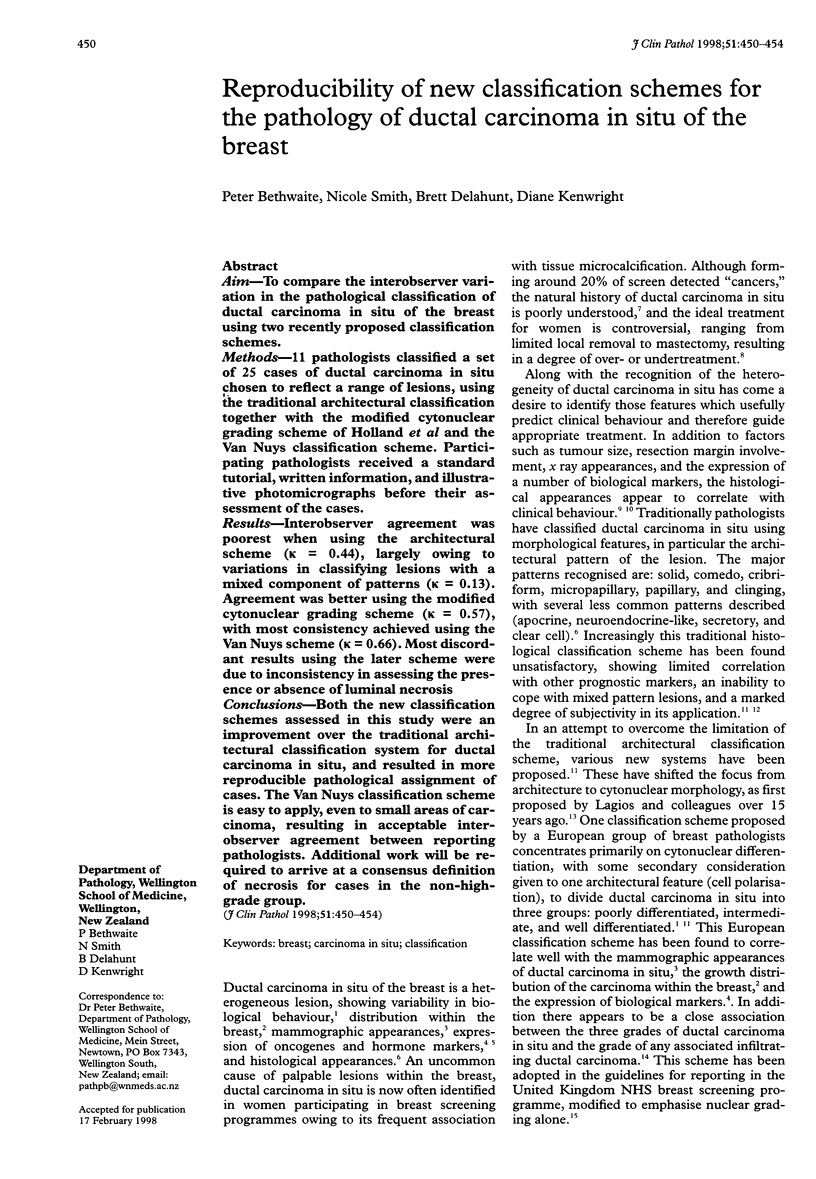
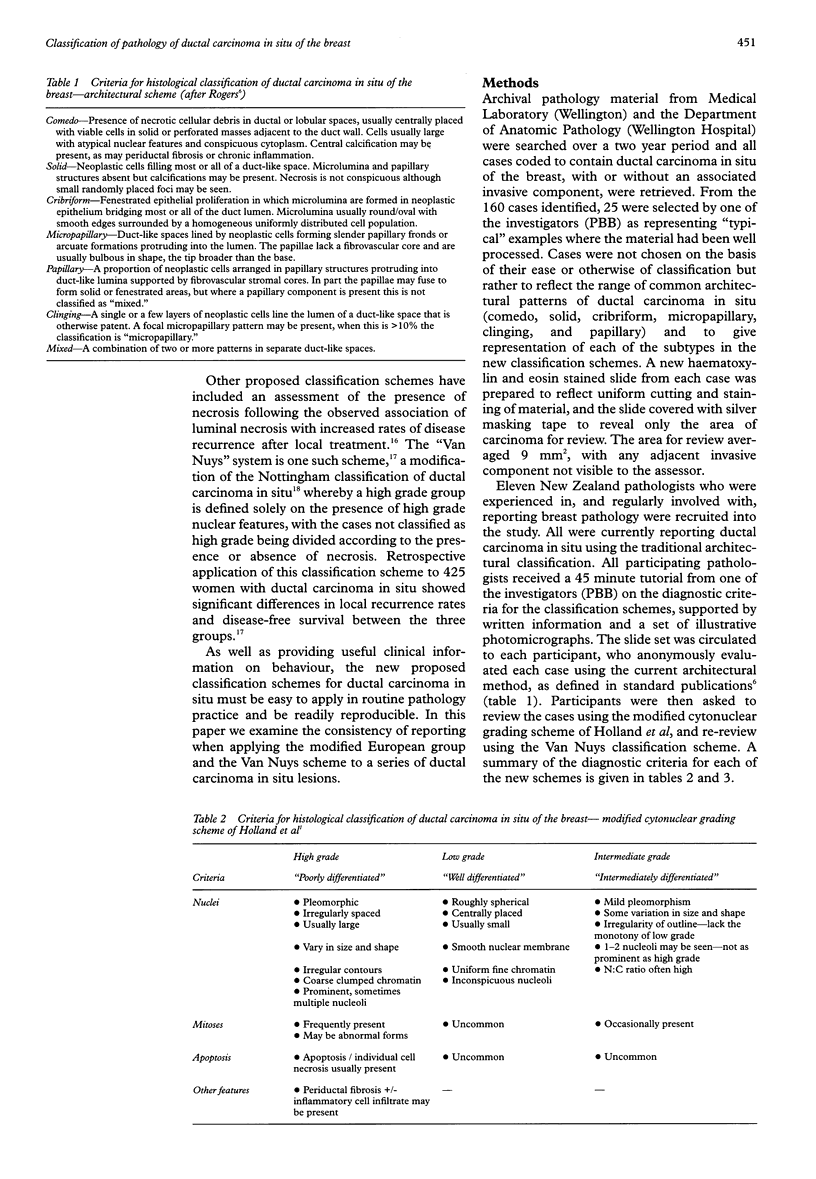
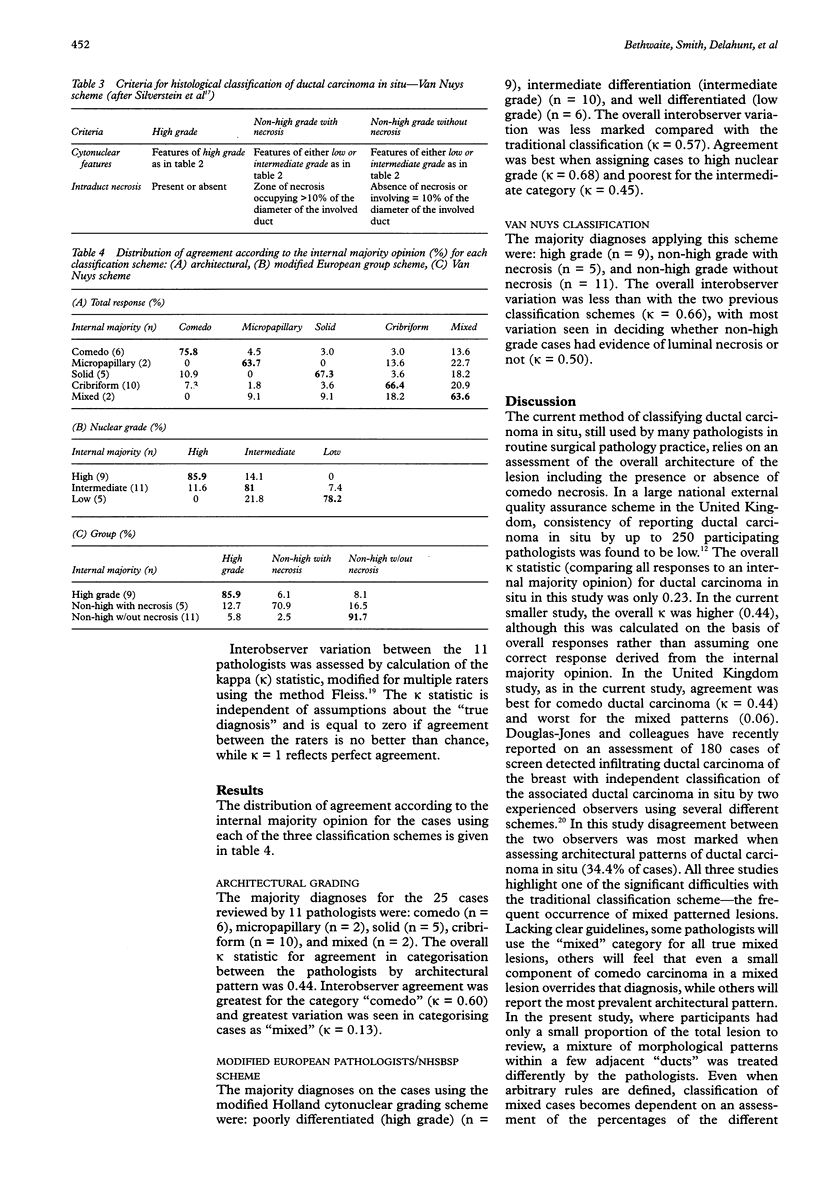
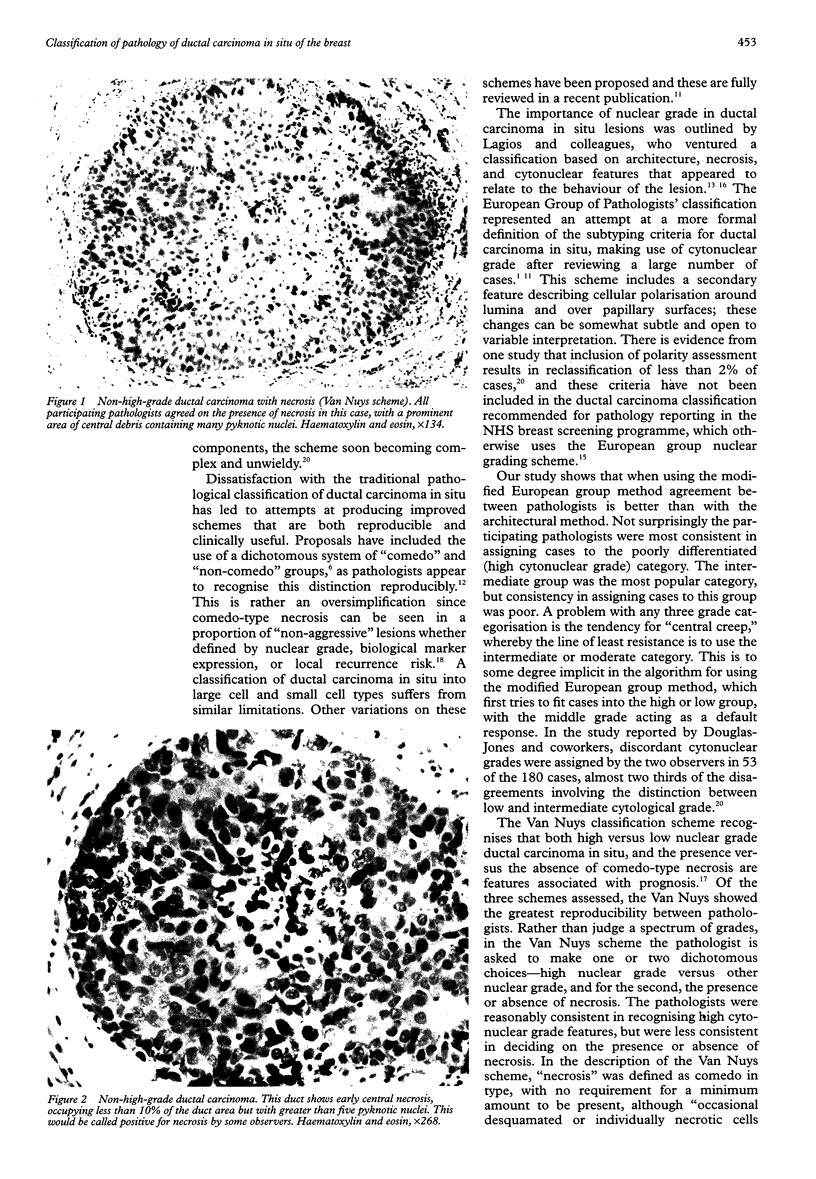
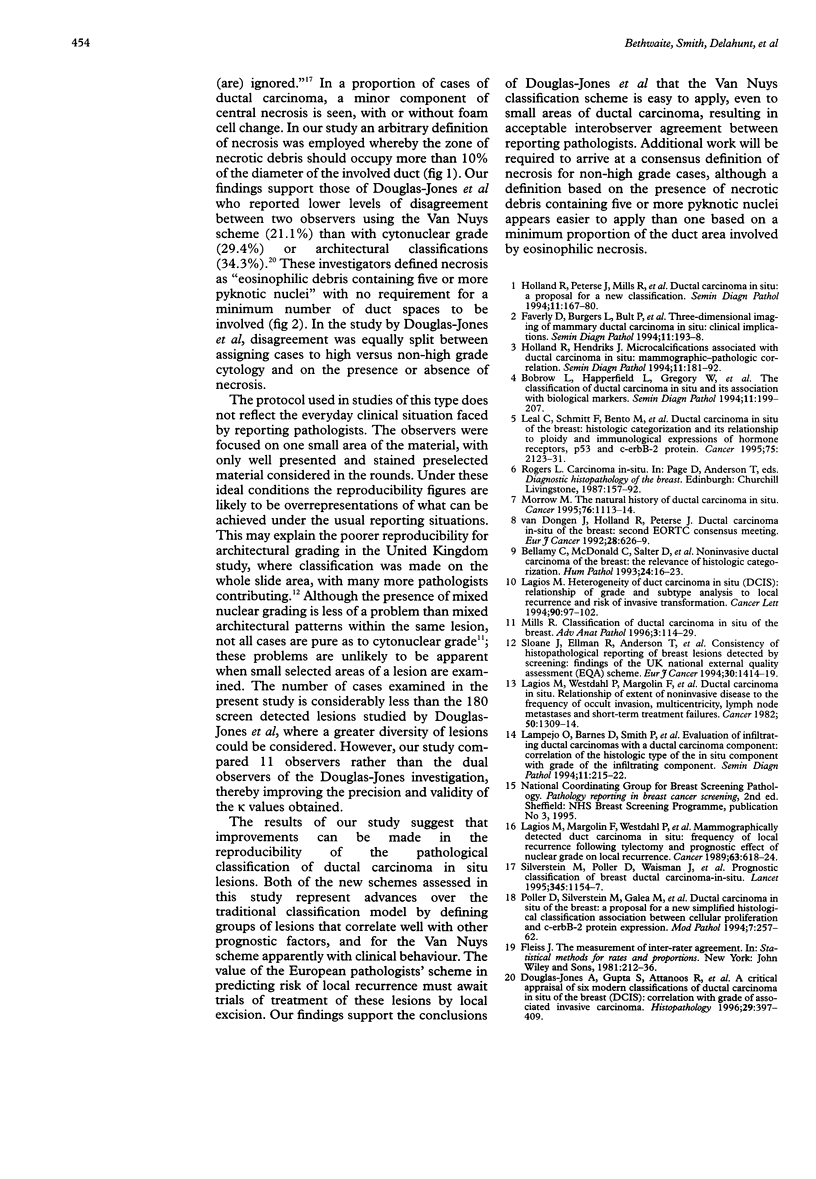
Images in this article
Selected References
These references are in PubMed. This may not be the complete list of references from this article.
- Bellamy C. O., McDonald C., Salter D. M., Chetty U., Anderson T. J. Noninvasive ductal carcinoma of the breast: the relevance of histologic categorization. Hum Pathol. 1993 Jan;24(1):16–23. doi: 10.1016/0046-8177(93)90057-n. [DOI] [PubMed] [Google Scholar]
- Bobrow L. G., Happerfield L. C., Gregory W. M., Springall R. D., Millis R. R. The classification of ductal carcinoma in situ and its association with biological markers. Semin Diagn Pathol. 1994 Aug;11(3):199–207. [PubMed] [Google Scholar]
- Douglas-Jones A. G., Gupta S. K., Attanoos R. L., Morgan J. M., Mansel R. E. A critical appraisal of six modern classifications of ductal carcinoma in situ of the breast (DCIS): correlation with grade of associated invasive carcinoma. Histopathology. 1996 Nov;29(5):397–409. doi: 10.1046/j.1365-2559.1996.d01-513.x. [DOI] [PubMed] [Google Scholar]
- Faverly D. R., Burgers L., Bult P., Holland R. Three dimensional imaging of mammary ductal carcinoma in situ: clinical implications. Semin Diagn Pathol. 1994 Aug;11(3):193–198. [PubMed] [Google Scholar]
- Holland R., Hendriks J. H. Microcalcifications associated with ductal carcinoma in situ: mammographic-pathologic correlation. Semin Diagn Pathol. 1994 Aug;11(3):181–192. [PubMed] [Google Scholar]
- Holland R., Peterse J. L., Millis R. R., Eusebi V., Faverly D., van de Vijver M. J., Zafrani B. Ductal carcinoma in situ: a proposal for a new classification. Semin Diagn Pathol. 1994 Aug;11(3):167–180. [PubMed] [Google Scholar]
- Lagios M. D. Heterogeneity of duct carcinoma in situ (DCIS): relationship of grade and subtype analysis to local recurrence and risk of invasive transformation. Cancer Lett. 1995 Mar 23;90(1):97–102. doi: 10.1016/0304-3835(94)03683-a. [DOI] [PubMed] [Google Scholar]
- Lagios M. D., Margolin F. R., Westdahl P. R., Rose M. R. Mammographically detected duct carcinoma in situ. Frequency of local recurrence following tylectomy and prognostic effect of nuclear grade on local recurrence. Cancer. 1989 Feb 15;63(4):618–624. doi: 10.1002/1097-0142(19890215)63:4<618::aid-cncr2820630403>3.0.co;2-j. [DOI] [PubMed] [Google Scholar]
- Lagios M. D., Westdahl P. R., Margolin F. R., Rose M. R. Duct carcinoma in situ. Relationship of extent of noninvasive disease to the frequency of occult invasion, multicentricity, lymph node metastases, and short-term treatment failures. Cancer. 1982 Oct 1;50(7):1309–1314. doi: 10.1002/1097-0142(19821001)50:7<1309::aid-cncr2820500716>3.0.co;2-#. [DOI] [PubMed] [Google Scholar]
- Lampejo O. T., Barnes D. M., Smith P., Millis R. R. Evaluation of infiltrating ductal carcinomas with a DCIS component: correlation of the histologic type of the in situ component with grade of the infiltrating component. Semin Diagn Pathol. 1994 Aug;11(3):215–222. [PubMed] [Google Scholar]
- Leal C. B., Schmitt F. C., Bento M. J., Maia N. C., Lopes C. S. Ductal carcinoma in situ of the breast. Histologic categorization and its relationship to ploidy and immunohistochemical expression of hormone receptors, p53, and c-erbB-2 protein. Cancer. 1995 Apr 15;75(8):2123–2131. doi: 10.1002/1097-0142(19950415)75:8<2123::aid-cncr2820750815>3.0.co;2-v. [DOI] [PubMed] [Google Scholar]
- Morrow M. The natural history of ductal carcinoma in situ. Implications for clinical decision making. Cancer. 1995 Oct 1;76(7):1113–1115. doi: 10.1002/1097-0142(19951001)76:7<1113::aid-cncr2820760702>3.0.co;2-u. [DOI] [PubMed] [Google Scholar]
- Poller D. N., Silverstein M. J., Galea M., Locker A. P., Elston C. W., Blamey R. W., Ellis I. O. Ideas in pathology. Ductal carcinoma in situ of the breast: a proposal for a new simplified histological classification association between cellular proliferation and c-erbB-2 protein expression. Mod Pathol. 1994 Feb;7(2):257–262. [PubMed] [Google Scholar]
- Silverstein M. J., Poller D. N., Waisman J. R., Colburn W. J., Barth A., Gierson E. D., Lewinsky B., Gamagami P., Slamon D. J. Prognostic classification of breast ductal carcinoma-in-situ. Lancet. 1995 May 6;345(8958):1154–1157. doi: 10.1016/s0140-6736(95)90982-6. [DOI] [PubMed] [Google Scholar]
- Sloane J. P., Ellman R., Anderson T. J., Brown C. L., Coyne J., Dallimore N. S., Davies J. D., Eakins D., Ellis I. O., Elston C. W. Consistency of histopathological reporting of breast lesions detected by screening: findings of the U.K. National External Quality Assessment (EQA) Scheme. U. K. National Coordinating Group for Breast Screening Pathology. Eur J Cancer. 1994;30A(10):1414–1419. doi: 10.1016/0959-8049(94)00261-3. [DOI] [PubMed] [Google Scholar]
- van Dongen J. A., Holland R., Peterse J. L., Fentiman I. S., Lagios M. D., Millis R. R., Recht A. Ductal carcinoma in-situ of the breast; second EORTC consensus meeting. Eur J Cancer. 1992;28(2-3):626–629. doi: 10.1016/s0959-8049(05)80113-3. [DOI] [PubMed] [Google Scholar]




